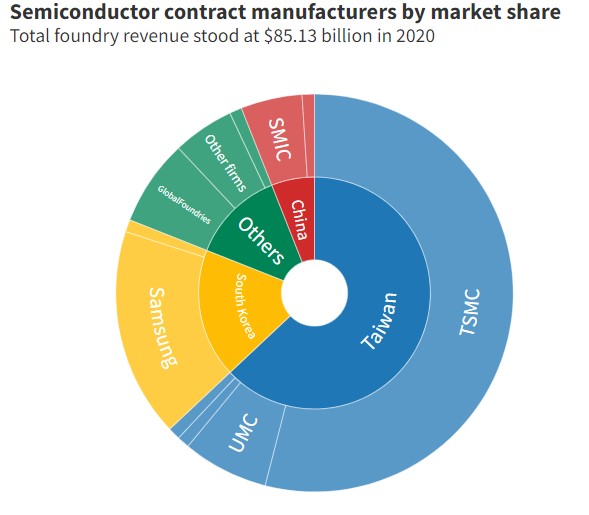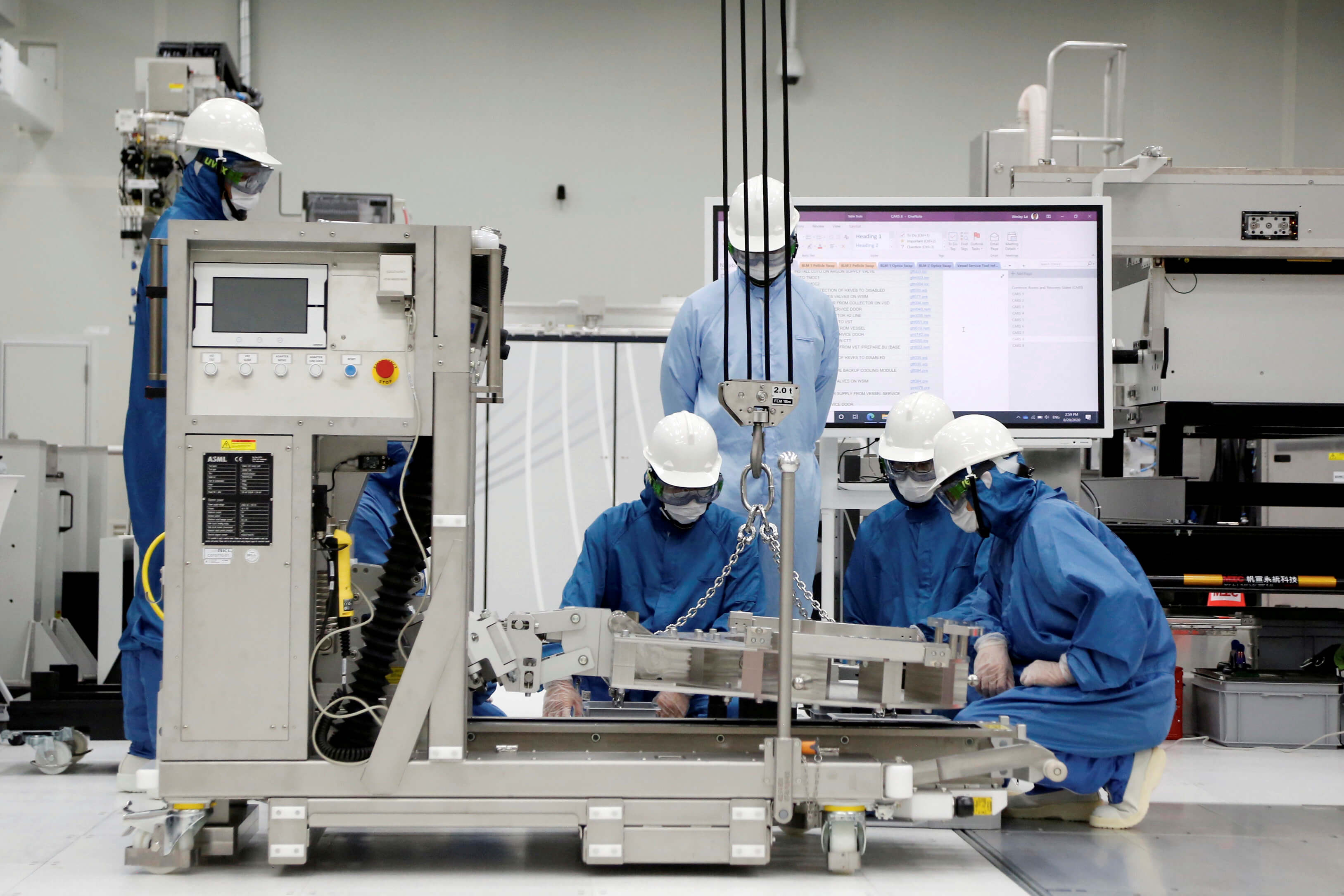New US chip rules threaten European strategic autonomy
President Joe Biden surprised friend and foe in October with new restrictions for the export of microchips and chip-making equipment to China in order to slow down its technological development. The US wants European companies to follow suit. Sanne van der Lugt and Frans-Paul van der Putten warn that the new restrictions threaten the competitiveness of European flagship companies in the microchip industry. "Without these prominent companies, it is difficult for the European Union to act autonomously in a global system that is increasingly dominated by great powers and large companies."
THE ISSUE
What is this about?
The US imposed new limits on American companies selling advanced computing chips to China. By making this move the Biden administration hopes to curtail Beijing’s access to critical technologies that are needed for advanced weapons and possibly also to limit the pace of China’s economic development.
What is the catch?
The Dutch company ASML is a major bottleneck for the chip supply chain worldwide. Washington tries to convince the Dutch government to stop ASML from exporting chip technology to China as well, but the costs of following the American export limits are much higher for European microchip companies than for American ones.
What does this mean for the EU?
Advanced computer chips are the future, but the EU's share of global chip revenues has gone down lately. If the European Union wants to become a world power to be reckoned with, which requires being able to act autonomously, it should make sure that it does not undercut important companies like the Dutch ASML when negotiating the limiting of chip exports to China.
The Dutch company ASML is a major bottleneck for the chip supply chain worldwide: many microchip manufacturers depend on ASML's advanced machines. As a matter of fact, ASML has a monopoly on the most sophisticated chip-making machines – the so-called EUV-systems – and controls 95 per cent of the world market for the one-generation-older DUV-systems. In other words, if ASML is not on board, the new American chip export rules will not be effective.
In 2018 and 2019, American officials successfully lobbied the Dutch government to revoke the export licenses for ASML’s EUV-systems destined for China. The American reasoning at that time was that the dual-use principle applied. In other words, with these most advanced systems, one could produce the most advanced chips and those chips could potentially be used for highly advanced weapon systems. After seeing a classified US intelligence report shared by White House officials in July 2019, the Dutch Prime Minister Mark Rutte agreed to ban the export of the EUV-systems to China.1
While Chinese companies could no longer buy EUV-systems after the export ban, their demand for relatively older DUV-systems increased. In the first quarter of 2022, Chinese demand for DUV-systems accounted for 34 per cent of ASML's sales. The microchips that these DUV-machines produce are currently the most commonly used chips and are used in, for example, cars, phones and computers. These machines are therefore a major source of revenue for ASML at the moment.
In 2020, the Dutch company sold 5.4 billion euros worth of DUV-machines, of which the advanced types accounted for almost 4 billion euros. Selling these machines is highly important to ASML because those revenues finance the high Research & Development (R&D) costs needed to develop new generation systems and stay ahead of the competition.
But with the new rules presented on 7 October, the US government wants – among other things – to extend the existing export restrictions to these advanced DUV-systems. Already in March 2021, the National Security Commission on Artificial Intelligence (NSCAI) recommended the US government to coordinate with Japan and the Netherlands and to “establish a policy of presumptive denial of export licenses” for EUV- as well as DUV-systems.2
This recommendation came with the “uncomfortable message” that “America is not prepared to defend or compete [with China] in the AI [artificial intelligence] era”.2 In other words, these rules are the American response to no longer being competitive and meant to slow down the technological development of China.
The American government tries to convince foreign partners to follow its example by putting forward arguments about security and dual use. However, the costs for European companies are much higher than for American companies – if the Dutch and Japanese government implement the same policies.
First of all, this is the case because the new rules focus on ‘lithography’ and ‘deposition’, two of the three steps in the process of making chips that European firms have a clear advantage in. American actors are more advanced in etching – the third step of the process. That step is left out of the new rules. Secondly, in the past it turned out that American firms have a much easier job applying for the required licenses to export chips and chip technology to China than European firms.3
That brings up the question: is security the main goal of these new rules? Which interests are at play?
It is important to know that there are several interests at play in this power struggle; together they contribute to a vicious circle. Measures by one country to protect its national or business interests are hurting the national or business interests of another country, provoking reactive measures.
The Chinese interest
First of all, there is the often underexposed Chinese interest in reducing fees and licensing costs. To be able to buy microchips from US-based suppliers, Chinese companies ought to possess US-approved licenses. These licensing fees can reach great heights. In 2017, Chinese companies earned about 1 billion US dollars from Western companies, but at the same time lost nearly 20 billion US dollars in (licensing) fees to Western companies. And in the past twenty years, Huawei alone has paid more than 6 billion US dollars in fees to mostly American companies for – among other things – the use of chips and other advanced technology. The US government often points to the trade deficit with China, but ignores the fact that China had a huge intellectual property deficit with the US and Europe.
Historically, the leader of a new industrial revolution has always become the world leader
In order to reduce its dependency from American companies, the Chinese government launched its ‘Made in China 2025 strategy’ in 2015. This strategy was aimed to move away from being the ‘world's factory’ and to upgrade the manufacturing capabilities of Chinese industries growing into a more technology-intensive powerhouse pushing for leadership in robotics, information technology, and clean energy, among other sectors. The programme has since become a source of contention for the US leadership, and has partly been a trigger for the trade war between the US and China.
The interest of the US
Second, there is the geopolitical interest of the US in defending its leadership role on the eve of a new industrial revolution. Such a revolution entails a major shift in how things are made and involves large-scale organisational and social changes. Historically, the leader of a new industrial revolution has always become the world leader.
For example, the invention of the steam engine in Britain marked the beginning of the first industrial revolution that helped Britain become the world's largest trading nation. With the invention of the computer and internet, the US became the undisputed leader during the third industrial revolution.4
The stakes for coming in top of this fourth revolution are incredibly high
The fourth industrial revolution, which we are currently going through, is mainly driven by 5G/6G and microchips. These technologies provide completely new technological applications, such as remote operations, automatic driving and – more worrying – weapons that can independently determine their target with the help of AI.
The stakes for coming in top of this fourth revolution are incredibly high. Late 2017, the US National Security Council warned President Donald Trump that if China were to be able to roll out a national 5G network before the US, China would “win economically, politically and militarily”.5 The American government realised that the US cannot build a 5G network on its own without the help of China (Huawei or ZTE) or Europe (Ericsson or Nokia), and that the US also depends on Asia and Europe for microchips. Figure 1 shows that almost all chips in the world are produced in Taiwan, South Korea and China.

Since that realisation, the US has tried to buy time to quickly fill the gaps in American technological capacity and maintain geopolitical leadership position in the world. In 2018, the US government tried hard to slow down the advance of Huawei as a leading technology company and tried to buy Ericsson to catch up quickly in the field of 5G. It was the same year that American officials started to lobby the Dutch government to revoke ASML's export licenses for its most advanced machines destined for China.6
The Japanese interest
Next to the interests of China and the US, there is lastly an underexposed Japanese interest at play in banning chip exports to China. ASML has only one real competitor left, and that is the Japanese company Nikon. Nikon controls the remaining 5 per cent of the market for the advanced DUV-machines. The company has been supplying 70 to 90 per cent of its machines to the American company Intel and is seeking out new customers in order to reduce its excessive reliance on Intel.7
Coordinating a ban on the export of DUV-systems to China with the US and the Netherlands was therefore a no-brainer for the Japanese government. Besides, the measurement mostly affects ASML and potentially increases the chance for the Japanese Nikon to keep up with its main Dutch competitor.

The Dutch government believes it has a good negotiation position in the talks with Japan and the US because of the vital role of ASML.8 However, does the Dutch government fully understand the US government’s geopolitical motives behind – and the consequences for European strategic autonomy of – banning the export of EUV- and the most advanced DUV-systems to China?
Nikon has used the momentum of recent China-US clashes to promote its systems to China with the claim that their machines do not contain American technology. This was a good selling point, especially considering that Nikon’s European competitors do use American technology. Even though a Dutch company like ASML uses relatively little American components, China still perceives this as a risk because – in the future – the US may require licenses for high-tech products from other countries containing American components.
The recent global chip shortages have shown European leaders how important microchips are for the latest technological developments
Under current regulations, the US can only require a license for high-tech products shipped to China from other countries if US-made components make up more than 25 per cent of the value. Since ASML’s EUV-machines do not meet the 25 per cent threshold this would require the US government to lowering the 25 per cent threshold for technology of American origin. That would however open up the possibility for a ban of the advanced DUV-machines. Therefore, to avoid uncertainty in the future, some Chinese companies have indeed switched to Japanese machines.
The Dutch interest
One important Dutch interest is clear by now: ASML is largely dependent on the sale of DUV-systems to maintain its competitive position. Agreements that put ASML at a disadvantage compared to its largest competitor endanger ASML's position. But the Dutch interests are greater than protecting a large successful Dutch company.
The recent global chip shortages have shown European leaders how important microchips are for the latest technological developments. According to a survey from the European Commission, European industry expects the demand for chips to double by 2030. This reflects the increasing importance of microchips for European industry and society. It will be a challenge to meet this rising demand. The EU's share of global chip revenues has dropped from 20 per cent in the 1990s to 10 per cent in 2022.9 The vast majority of chips are designed in the US and made in Asia.
The EU has set itself the goal to increase its chip market share to 20 per cent by 2030. It is not self-evident that the EU will succeed, because the chain is extremely dependent on a very limited number of actors. The trump cards that the EU holds to move these actors in line with the European ambitions are the Belgian IMEC and the Dutch ASML and ASM. It is therefore very important that the Dutch government seeks backing from Paris, Berlin and Brussels in its negotiations with the United States and conducts these negotiations at the European level. That is the place where the Dutch and Belgium negotiation powers lie and where European strategic autonomy is best defended.
- 1Alexandra Alper, Toby Sterling, Stephen Nellis, ‘Trump administration pressed Dutch hard to cancel China chip-equipment sale: sources’, Reuters, 6 January 2020.
- 2 a b National Security Commission on Artificial Intelligence, ‘Final Report’, March 2021
- 3Similar to the restrictions for the export of American technology to the Chinese firms Huawei and SMIC in 2020, the new regulations announced on 7 October require suppliers to get an export license to sell certain equipment to China. It is the American Commerce Department that grants these licenses. Documents released by the Commerce Department in 2021 show that more than 9 out of 10 license applications were granted to SMIC suppliers while 69 per cent of requests to ship to Huawei were approved over the same period. Dutch companies complained in personal conversations with the authors that their American competitors received the required licenses quicker and more often.
- 4The second industrial revolution took place in the late nineteenth and early twentieth centuries, and led to innovations such as cars and airplanes, telegraph and telephone, electric power and industrial mass production of consumer goods.
- 5Jonathan Swan, David McCabe, Ina Fried and Kim Hart, ‘Scoop: Trump team considers nationalizing 5G network’, Axios, 28 January 2018.
- 6Alexandra Alper, Toby Sterling, Stephen Nellis, ‘Trump administration pressed Dutch hard to cancel China chip-equipment sale: sources’, Reuters, 6 January 2020.
- 7Takeshi Hashimoto, ‘Nikon plans reform to reduce reliance on key customer Intel’, Nikkei Asia, 22 november 2020.
- 8Cagan Koc and Debby Wu, ‘Dutch Minister Says US Can’t Dictate Approach to China Exports’, Bloomberg, 18 November 2022.
- 9Kjeld van Wieringen, ‘Strengthening EU chip capabilities: How will the chips act reinforce Europe's semiconductor sector by 2030?’, EPRS, July 2022.






0 Reacties
Reactie toevoegen